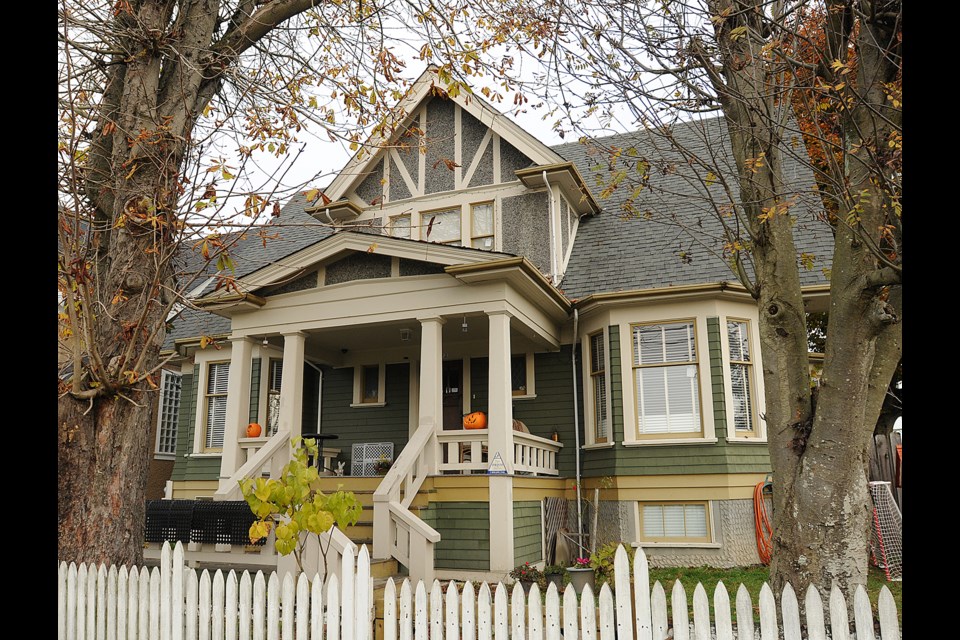ibMany houses in Victoria-Fraserview were built in the 1950s during the post-war population boom, but a few notable heritage homes remain.
One is at 5709 Wales St. “This was a prominent corner property — a farmhouse that was built in 1911 and later subdivided, but it is one of the oldest remaining homes, along with the other two on Wales, in the area,” heritage expert Donald Luxton told the Courier.
Another on Wales Street is the Craftsman-style farmhouse at 5805 Wales St. on the old Avalon Dairy site built by Avalon founder Jeremiah Crowley in 1908.
It’s important “for its modest vernacular architecture. The front-gabled house features a front-gabled entryway, saddlebag dormers and simple decorative features,” according to a 2012 Statement of Significance produced by Donald Luxton and Associates Inc. “Its simple, robust construction reflects its original rural nature and the typical construction of the Edwardian era.”
A development is being considered for the site. Last August, the city asked the developer, Avalonna Homes, to rethink its rezoning application after two city advisory groups rejected its proposal. The property is zoned single-family residential, so the owner could subdivide it into 10 or 11 lots and knock down the farmhouse. The city is willing to consider extra density to preserve the farmhouse. Hywel Jones of Hywel Jones Architect Ltd., which submitted the application on behalf of Avalonna Homes, said he would refine the scheme.
“We are still working on it,” Jones said in an email to the Courier Thursday.
A third significant home on Wales Street is Cooper House at 5872 Wales St., which was built in 1919 for the Cooper family. “The story is that it was one of the houses built immediately after the end of the First World War for the resettlement of returning soldiers,” explained Luxton who was born in the 1950s and grew up in a neighbourhood west of Victoria-Fraserview.
“[Victoria-Fraserview] is the old south Vancouver municipality that combined with the rest in the city in 1929, so it was pretty rural at the time,” Luxton recalled. “I certainly remember when I was a kid growing up that there were still remnant farms and livestock and all kinds of things out in that part of the world. That ultimately all disappeared, except for, of course, the remnants of Avalon Dairy, which is the last remaining vestige of that.”
Land, he said, was subdivided very quickly after the Second World War due to demand for housing from returning soldiers.
“All the guys being demobilized from the Second World War were really coming into the coast. A lot of them had come off the prairies and back east.
They hit the east and west coast when they were demobilized and a lot of them stayed. At the same time, a lot of people moved off the prairies who had been locked into place for food production during the war. They were free to move around all of a sudden, so there were a lot of people moving both east and west. A whole bunch of people settled in Vancouver at the time.”
While Victoria-Fraserview may not have the number of historical buildings found in other parts of the city, Luxton still finds the neighbourhood interesting.
"The streetscapes aren't as consistent or as interesting as some of the others in the city, but certainly they have their historical interest. What I find most important about the neighbourhood is it shows that transition from kind of an agricultural area to a post-war suburb and it does have its charms," he said.
"It's an entirely different style of street design. There are more curved streets, there are more cul-de-sacs, there are more of those kinds of things going on, but also the plantings are really different. There are more cherry trees and lower plantings than there are in older parts of the city, so it shows a more contemporary sensibility."
because it illustrates the transition from an agricultural area to a post-war suburb.



